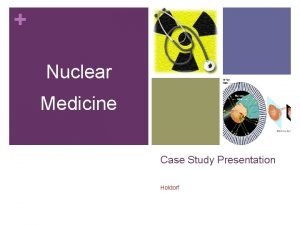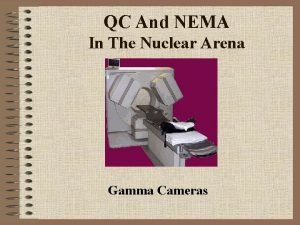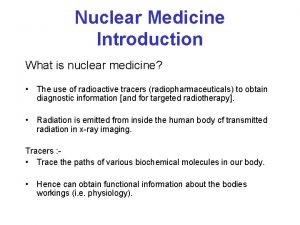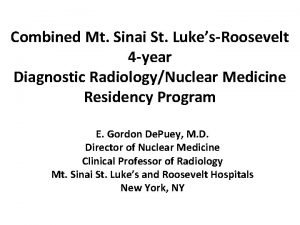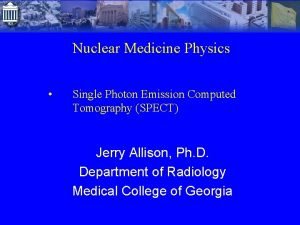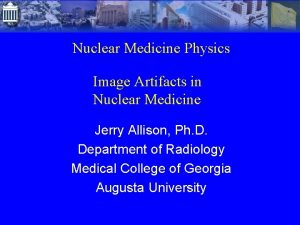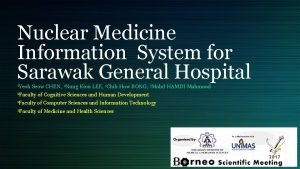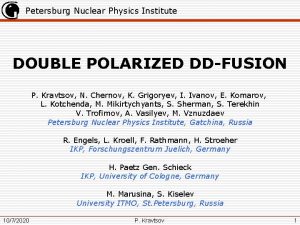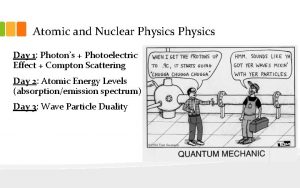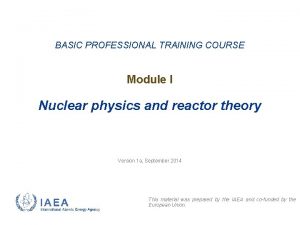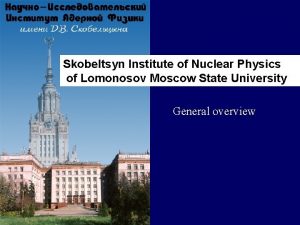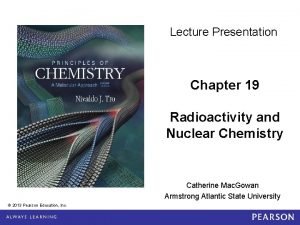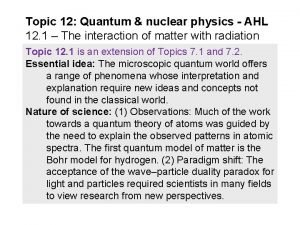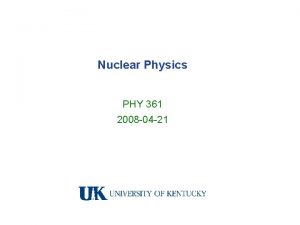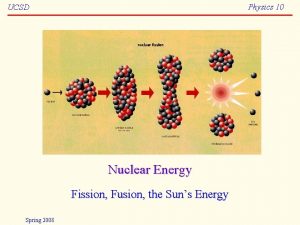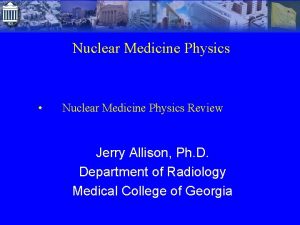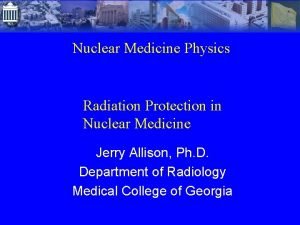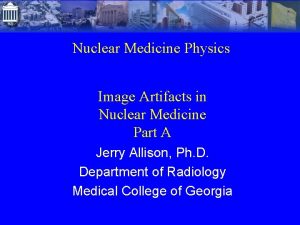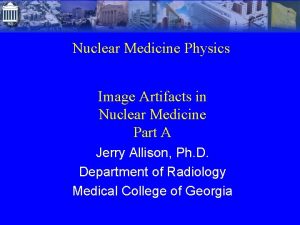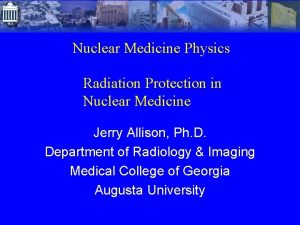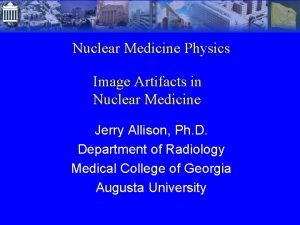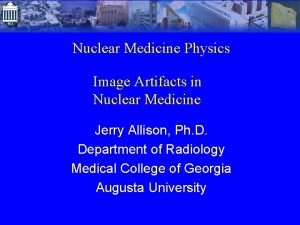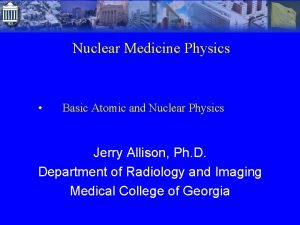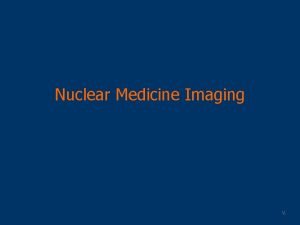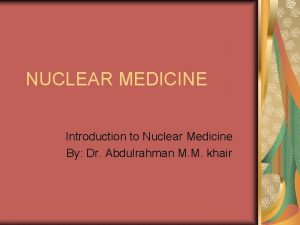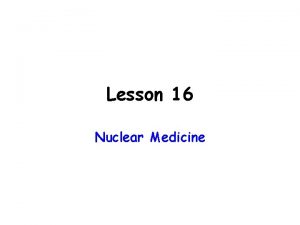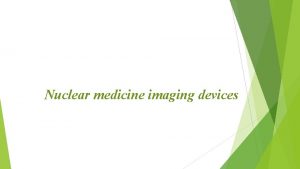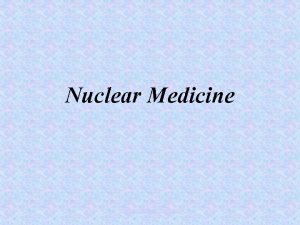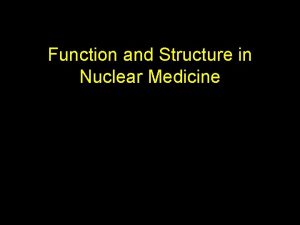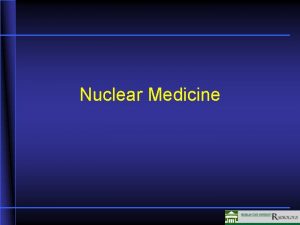Nuclear Medicine Nuclear medicine physics What is Nuclear




















- Slides: 20

Nuclear Medicine

Nuclear medicine physics

What is Nuclear Medicine Also known as nuclide imaging • Introduce radioactive substance into body • Allow for distribution and uptake/metabolism of compound ⇒Functional Imaging! • Detect regional variations of radioactivity as indication of presence or absence of specific physiologic function • Detection by “gamma camera” or detector array • (Image reconstruction)

What is Nuclear Medicine In broad terms nuclear medicine is defined as a medical specialty use safe, painless & coast effective technique involving the application of radioactive substances which administered to a patient by ( IV injection, orally or by inhalation )and the distribution of radioactivity in the body is determined by an external radiation detector ( Gamma camera) used in the diagnosis and treatment of human disease.

• Steps: –Inject radio tracers into the body –The radio tracers undergo radioactive decay and generate gammy rays –A camera detect gamma rays from the radio tracer after a certain time. • Different physiological functions are imaged by using different radio tracers • X-ray projection and tomography: –X-ray transmitted through a body from an outside source to a detector measuring anatomic structure • Nuclear medicine: –Gamma rays emitted from within a body –Emission computed tomography –Two popular method: • Positron Emission Tomography (PET) • Single photon emission computed tomography (SPECT)

Atomic Structure An atom={a nucleus, electrons} • nucleons = {protons; neutrons} • Nuclide: unique combination of protons and neutrons in a nucleus • mass number A : no. of protons + no. of neutrons • atomic number Z = no. of protons in an atom “e. g. , all atoms with 6 protons are carbon atom” “ the isotopes have the same atomic no. but differ in the no. of neutrons • An element is denoted by its A and Z e. g. , Carbon 12: has mass no. of 12( 6 protons+6 neutrons) & 6 elect. Carbon 14: has mass no. of 14( 6 protons+ 8 neutrons) & 6 elect. these two form of Carbon are Isotopes

Stable vs. Unstable Nuclides - Radioactive atoms have unstable nuclei and they will eventually release subatomic particles to become more stable giving off energy- radiation- in the process known as decay. e. g. , carbon-12 and carbon-13 are stable, while carbon-14 is radioactive. These forms of carbon are found in the atmosphere in relatively constant proportions , with C-12 as a major form 99%, C-13 as a minor form at 1% and C-14 present only in tiny amount “tracer” - The radioactive decay can cause change in the no. of protons in the nucleus , when this happen, the identity of the atom changes (e. g. , Carbone-14 decaying to nitrogen-14. ) - often, elements come in both radioactive and nonradioactive versions that differ in the no. of neutrons they contain are so called isotopes

Definitions Isotopes: are atomic structures of same elements having a different mass number/atomic mass (e. g. C-12 and C-11 –Chemically identical. ) • Isobars: are different chemical elements having same atomic mass (e. g. 11 Na 24 12 Mg 24 Carbon-11 and boron-11. ) • Isotones: atoms with the same number of neutrons but different A. • Isomers: atoms of the same number of protons and the same number of neutrons but differ in energy and manner of radioactive decay (produced after gamma decay).



What is Radioactivity?

Decay Modes

Positron Decay Also known as β+ decay Beta Plus decay : in which a proton inside a radionuclide nucleus is converted into a neutron while releasing a positron and an electron neutrino (νe), a positron (positive electron), Mass number A does not change, proton number Z reduces

Gamma Decay (Isometric Transition) A nucleus (which is unstable) changes from a higher energy state to a lower energy state through the emission of electromagnetic radiation (photons) (called gamma rays). The daughter and parent atoms are isomers. The gamma photon is used in Single photon emission computed tomography (SPECT) Gamma rays have the same property as X-rays, but are generated different: –X-ray through energetic electron interactions. –Gamma-ray through isometric transition in nucleus.

Half-Life Radiotracers: Desired Property Half life is the time takes for radioactivity to decrease by half. Decay mode: –Clean gamma decay: do not emit alpha or beta articles – Positron decay: positron will annihilate” destroyed” with electrons to produce gamma rays. • Energy of photon: –Should be high so that photons can leave the body w/ little attenuation –Hard to detect if the energy is too high –Desired energy range: 70 -511 Ke. V. • Half-life –Should not be too short (before detector can capture) or too long (longer patient scan time) –Minutes to hours desired. .

Radionuclides in Clinical Use Most naturally occurring radioactive isotopes not clinically useful (long T 1/2, charged particle emission, alpha or beta decay) Artificial radioactive isotopes produced by bombarding stable isotopes with high-energy photons or charged particles. Nuclear reactors (n), charged particle accelerators (Linacs, Cyclotrons)

The Technetium Generator Can be produced from an on-site generator – , ⁹⁹ᵐTc : A pure gamma emitter widely used in nuclear medicine obtained through the decay of molybdenum Mo-99 in a nuclear reactor. According to the flowchart, the emission of a beta electron leaves behind an excited nucleus, which returns to its ground state by emitting a gamma photon. Excited state is ⁹⁹ᵐTc • Decay characteristics of Tc-99 -m: –half life =6. 0 hrs, emitting E=140 Ke. V gamma rays without accompanying beta rays. The radioisotope placed in a radiopharmaceutical serum is then injected into the patient. • Used in more than 90% of nuclear imaging

Radiopharmaceuticals also known as radiopharmacy, involves preparation of radioactive materials for patient administration that will be used to diagnose and treat specific diseases in nuclear medicine (cancer, myocardial perfusion, brain perfusion). Gamma emitter – 99 m. Tc-Sestamibi – 99 m. Tc-labeled hexamethyl-propyleneamine(brain perfusion). • Positron emitters – 11 C, T 1/2= 20 min • CO 2 (cerebral blood flow), O 2(myoc. O 2 consumption), H 2 O (myoc. O 2 consumption & blood perfusion) • [18 F]-fluorodeoxyglucose (FDG, neurology, cardiology, oncology, metabolic activity)

Common Radiotracers

Summary Nuclear medicine relies on radiation (gamma rays) generated through radioactive decay. Radioactive decay is the process when a unstable nuclide is changed to a more stable one –Four modes of decay, generating alpha particles, beta particles, positrons and gamma rays respectively. Radioactivity follows an exponential decay law, characterized by the decay constant or the half-life. • Desired properties for radio tracers. • Common radiotracers in nuclear medicine.
 Lesson 15 nuclear quest nuclear reactions
Lesson 15 nuclear quest nuclear reactions Fisión nuclear vs fision nuclear
Fisión nuclear vs fision nuclear Case study conclusion
Case study conclusion Intranet venus
Intranet venus Orthogonal hole phantom
Orthogonal hole phantom Neuclear medicine
Neuclear medicine Mt sinai nuclear medicine
Mt sinai nuclear medicine Nuclear medicine
Nuclear medicine Diaphragm
Diaphragm Nuclear medicine information system
Nuclear medicine information system Nuclear medicine lectures
Nuclear medicine lectures Petersburg nuclear physics institute
Petersburg nuclear physics institute Nuclear physics day
Nuclear physics day Nuclear physics
Nuclear physics Skobeltsyn institute of nuclear physics
Skobeltsyn institute of nuclear physics Nuclear magic numbers
Nuclear magic numbers Quantum nuclear physics
Quantum nuclear physics Nuclear physics
Nuclear physics Scattering cross section in nuclear physics
Scattering cross section in nuclear physics Nuclear energy in physics
Nuclear energy in physics Nuclear physics
Nuclear physics


